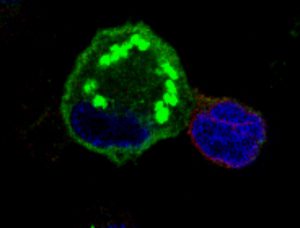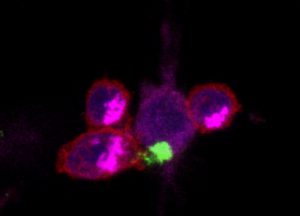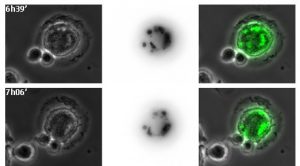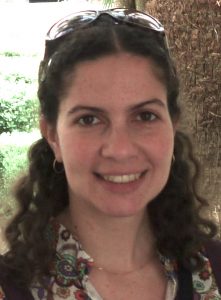

Bruna Cunha de Alencar Bargieri
Laboratory: Biologia Celular do Sistema Imune
Phone: +55 (11) 3091 7394
E-mail: bruna.alencar@usp.br
Lattes: http://lattes.cnpq.br/8239591812587453
Research Line:
The lab is interested on the molecular studies of cell machineries involved in several functions of immune cells, both during their normal functioning and after infection. Currently, the lab’s main focus resides in the role of motor proteins called myosins in the interactions between macrophages, dendritic cells and T lymphocytes with HIV.
We work with human cell lines and primary human cells, and use virology, immunology, biochemical and molecular biology techniques, including RNAi and microscopy.
Projects:
HIV debilitates the immune system mainly through the infection and destruction of CD4+ T lymphocytes. However, other cells of the immune system can interact with the virus and are important in the course of infection. That is the case os macrophages and dendritic cells. Macrophages can be infected by HIV-1, are involved in HIV-associated dementia, and are considered virus reservoirs. Dendritic cells, on the other hand, can transmit the virus to CD4+ T lymphocytes without becoming infected themselves, in a processes known as trans-infection. For that reason, dendritic cells are considered important to HIV-1 dissemination.
Siglec1 signaling in dendritic cells after binding HIV
During trans-infection, dendritic cells internalize HIV using the receptor Siglec1. The mechanisms involved in virus internalization and signaling mediated by this molecule, though, are poorly understood. Using proteomic and RNAi techniques, the lab aims at better understanding these pathways.
Role of myosins in HIV trans-infecion by dendritic cells and HIV replication in macrophages and T lymphocytes
Myosins are a large superfamily of molecular motors that move on the actin network and mediate some of its functions. Several pieces of evidence point to the fact that HIV-1 coopts the actin network at several steps of its cycle. Despite that, little is known about the motor proteins involved in HIV-1 replication and transmission.
Our projects aim at studying the role of myosins in HIV-1 cycle in macrophages and CD4 T lymphocytes, as well as in trans-infection mediated by dendritic cells. Using RNAi-based gene silencing in human cells, our goal is to describe which myosins participate in these processes, at which steps, and their role.
Role of unconventional myosins in CD4+ T cell activation
Type II myosins are known as conventional myosins. Non-muscle myosins II have been shown to be involved in immunological synapse formation during T cell activation. The role of unconventional myosins, though, has so far only been explored in T cell migration. Our lab is thus studying the possible participation of some unconventional myosins in T cell activation, using a cell line model and RNAi.
Role of myosins in inflammasome activation
It is known that the cytoskeleton participates in the activation of inflammasome complexes, both for NLRP3 and for pyrin pathways. In collaboration with Prof. Alessandra Pontillo’s lab, we will study the participation of some myosins in the activation of the above mentioned inflammasomes in monocytic cell lines.

Secção confocal de macrófago infectado com HIV-1, em co-cultura com linfócito T CD4.
Estão marcados: proteína Gag do HIV-1 (verde), CD3 (linfócito T, vermelho), núcleos celulares (azul).

Projeção de diversas secções confocais de uma célula dendrítica (centro) pulsada com HIV-1, em contato com linfócitos T CD4. Foram marcadas: a proteína Env do HIV-1 (verde), CD3 (linfócitos T, vermelho), CD81 (linfócitos e célula dendrítica, rosa) e os núcleos celulares (azul).

Imagens de vídeo-microscopia de interações entre macrófagos infectados pelo HIV-1 e linfócitos T CD4 (Jurkats). O HIV-1 utilizado expressa uma proteína viral Gag em fusão com uma proteína fluorescente verde (GFP). À esquerda, imagem de contraste de fase. No centro, imagem de fluorescência. À direita, superposição da imagem de fluorescência (verde) sobre contraste de fase.
Publications:
Pietrobon AJ, Yoshikawa FSY, Oliveira LM, Pereira NZ, Matozo T, de Alencar BC, Duarte AJS, Sato MN. Antiviral Response Induced by TLR7/TLR8 Activation Inhibits HIV-1 Infection in Cord Blood Macrophages. Journal of Infectious Diseases, Aug 6:jiab389, 2021.
DOS REIS, E.C. , NUNES, V.C.L., SOARES, J.L.S., FERNANDES, F.P., SOUZA DE LIMA, D., DE ALENCAR, B.C., PONTILLO, A. Flagellin/NLRC4 pathway rescues NLRP3-inflammasome defect in dendritic cells from HIV+ patients: perspective for new adjuvant in immunocompromised individuals. Frontiers in Immunology, 10, 1291, 2019.
SOUZA DE LIMA, D. ; NUNES, V.C.L. ; OGUSKU, M.M. ; SADAHIRO, A. ; PONTILLO, A. ; ALENCAR, B.C. Polymorphisms in SIGLEC1 contribute to susceptibility to pulmonary active tuberculosis possibly through the modulation of IL-1ß. Infection, Genetics and Evolution 55:313-317, 2017.
DECALF, J. ; DESDOUITS, M. ; RODRIGUES, V. ; GOBERT, F.X. ; GENTILI, M. ; MARQUES-LADEIRA, S. ; CHAMONTIN, C. ; MOUGEL, M. ; CUNHA DE ALENCAR, B. ; BENAROCH, P. Sensing of HIV-1 Entry Triggers a Type I Interferon Response in Human Primary Macrophages. The Journal of Virology 12;91(15), 2017.
GAUDIN, R. ; DE ALENCAR, B. C. ; ARHEL, N. ; BENAROCH, P. HIV trafficking in host cells: motors wanted!. Trends in Cell Biology (Regular ed.) v. 23, p. 652-662, 2013.
BERRE, S. ; GAUDIN, R. ; Cunha de Alencar, B. ; DESDOUITS, M. ; Chabaud, M. ; NAFFAKH, N. ; RABAZA-GAIRI, M. ; GOBERT, F.-X. ; JOUVE, M. ; BENAROCH, P. . CD36-specific antibodies block release of HIV-1 from infected primary macrophages and its transmission to T cells. The Journal of Experimental Medicine, v. 210, p. 2523-2538, 2013.
Gaudin R, de Alencar BC*, Jouve M*, LeBouder E, Berre S, Schindler M, Gobert FX, Benaroch P. Critical role for the kinesin KIF3 in the HIV life cycle in primary macrophages. J Cell Biol. Oct 29;199(3):467-79, 2012.
Copyright © 2025 Programa de Pós-Graduação em Imunologia | Produzido por SCS - Mídias Online


